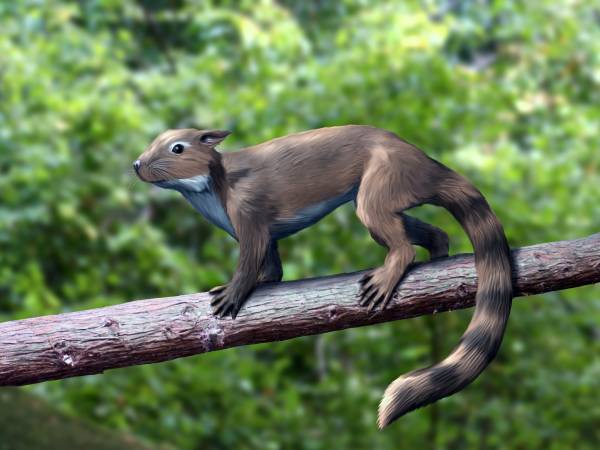Euharamiyida on:
[Wikipedia]
[Google]
[Amazon]
Euharamiyida also known as Eleutherodontida, is
 The position of euharamyidans is contested. They are either considered crown group mammals as members of
The position of euharamyidans is contested. They are either considered crown group mammals as members of
clade
In biology, a clade (), also known as a Monophyly, monophyletic group or natural group, is a group of organisms that is composed of a common ancestor and all of its descendants. Clades are the fundamental unit of cladistics, a modern approach t ...
of early mammal
A mammal () is a vertebrate animal of the Class (biology), class Mammalia (). Mammals are characterised by the presence of milk-producing mammary glands for feeding their young, a broad neocortex region of the brain, fur or hair, and three ...
s or mammal-like cynodont
Cynodontia () is a clade of eutheriodont therapsids that first appeared in the Late Permian (approximately 260 Megaannum, mya), and extensively diversified after the Permian–Triassic extinction event. Mammals are cynodonts, as are their extin ...
s from the Middle Jurassic to Early Cretaceous of Eurasia and possibly North America. The group is sometimes considered a sister group
In phylogenetics, a sister group or sister taxon, also called an adelphotaxon, comprises the closest relative(s) of another given unit in an evolutionary tree.
Definition
The expression is most easily illustrated by a cladogram:
Taxon A and ...
to Multituberculata
Multituberculata (commonly known as multituberculates, named for the multiple tubercles of their teeth) is an extinct Order (biology), order of rodent-like mammals with a fossil record spanning over 130 million years. They first appeared in the M ...
, or part of an earlier divergence within the synapsid
Synapsida is a diverse group of tetrapod vertebrates that includes all mammals and their extinct relatives. It is one of the two major clades of the group Amniota, the other being the more diverse group Sauropsida (which includes all extant rept ...
line. It is disputed whether or not they are related to the haramiyids from the Late Triassic, such as '' Haramiyavia''. The morphology of their teeth indicates that they were herbivorous or omnivorous. Some members of the group are known to be arboreal
Arboreal locomotion is the locomotion of animals in trees. In habitats in which trees are present, animals have evolved to move in them. Some animals may scale trees only occasionally (scansorial), but others are exclusively arboreal. The hab ...
, including gliding forms similar to modern flying squirrels
Flying squirrels (scientifically known as Pteromyini or Petauristini) are a tribe (biology), tribe of 50 species of squirrels in the family (biology), family Squirrel, Sciuridae. Despite their name, they are not in fact capable of full flight i ...
or colugos.
Evolution
 The position of euharamyidans is contested. They are either considered crown group mammals as members of
The position of euharamyidans is contested. They are either considered crown group mammals as members of Allotheria
Allotheria (meaning "other beasts", from the Ancient Greek language, Greek , '–other and , '–wild animal) is an extinct clade of mammals known from the Mesozoic and early Cenozoic. Shared characteristics of the group are the presence of lower ...
, related to multituberculates, or stem-group mammals within Mammaliaformes
Mammaliaformes ("mammalian forms") is a clade of synapsid tetrapods that includes the crown group mammals and their closest extinct relatives; the group radiated from earlier probainognathian cynodonts during the Late Triassic. It is defined as ...
. The position is often dependent on the relationships of euharamiyids to the Late Triassic haramiyids such as '' Haramiyavia'' and ''Thomasia''. In some studies, the two groups are recovered as unrelated.X.-Z. Luo, Q.-J. Meng, D. M. Grossnickle, D. Lui, A. I. Neander, Y.-G. Zhang, and Q. Ji. 2017. New evidence for mammaliaform ear evolution and feeding adaptation in a Jurassic ecosystem. Nature 548:326-329.
Phylogeny
Taxa
The following taxonomy follows Mao et al. (2022) unless otherwise cited. * '' Cryoharamiya'' * ''Maiopatagium
''Maiopatagium'' is an extinct genus of gliding euharamiyida, euharamiyids which existed in Asia during the Jurassic period. It possessed a patagium between its limbs and presumably had similar lifestyle to living Flying squirrel, flying squirrel ...
''
* '' Millosodon''
* '' Sharypovoia''
* '' Sineleutherus''
* '' Woodeatonia''
* ?'' Allostaffia''
* ? Hahnodontidae Sigogneau-Russell, 1991
* ?''Megaconus
''Megaconus'' is an extinct genus of allotherian mammal from the Middle Jurassic Tiaojishan Formation of Inner Mongolia, China. The type and only species, ''Megaconus mammaliaformis'' was first described in the journal ''Nature'' in 2013. ''Mega ...
''
* ? Gondwanatheria
* Arboroharamiyidae Zheng ''et al.'', 2013
** ''Arboroharamiya
''Arboroharamiya'' is an extinct genus of mammaliaform from the Late Jurassic Tiaojishan Formation of Inner Mongolia, China. ''Arboroharamiya'' belongs to a group of mammaliaforms called Haramiyida. The genus contains three species: ''A. jenkins ...
''
** ''Vilevolodon
''Vilevolodon'' is an extinct, monotypic genus of volant, arboreal euharamiyids from the Oxfordian age of the Late Jurassic of China. The type species is ''Vilevolodon diplomylos''. The genus name ''Vilevolodon'' references its gliding capabili ...
''
** ''Xianshou
''Xianshou'' is a genus of glidingQing-Jin Meng; David M. Grossnickle; Di Liu; Yu-Guang Zhang; April I. Neander; Qiang Ji; Zhe-Xi Luo (2017). "New gliding mammaliaforms from the Jurassic". ''Nature''. in press. . haramiyidan synapsid known from t ...
''
* Kermackodontidae Butler and Hooker, 2005 (="Eleutherodontidae" Kermack et al., 1998) (considered by other studies to be multituberculates)
** '' Kermackodon''
** '' Butlerodon''
* Shenshouidae Mao and Meng, 2019
** '' Qishou''
** '' Shenshou''
References
{{Taxonbar, from=Q18231220 Jurassic first appearances Jurassic extinctions Taxa named by Shundong Bi Taxa named by Yuanqing Wang Taxa named by Xia Sheng Taxa named by Jin Meng